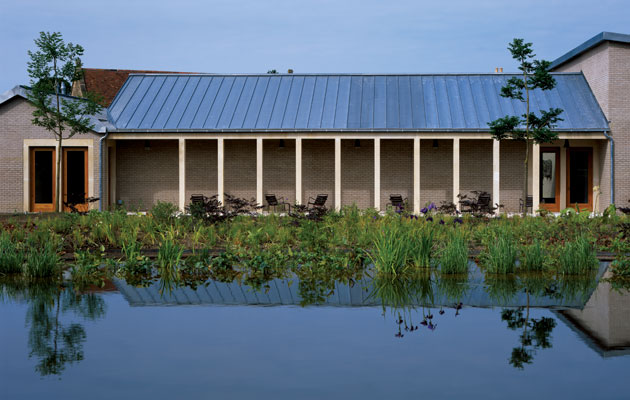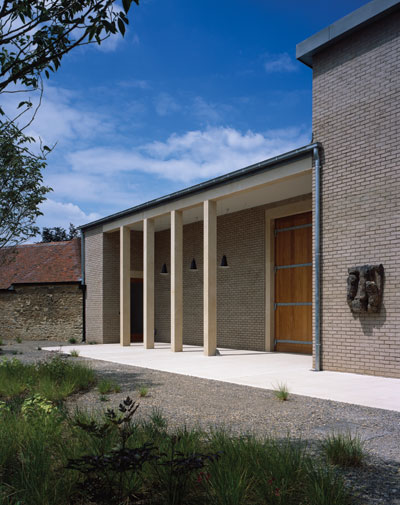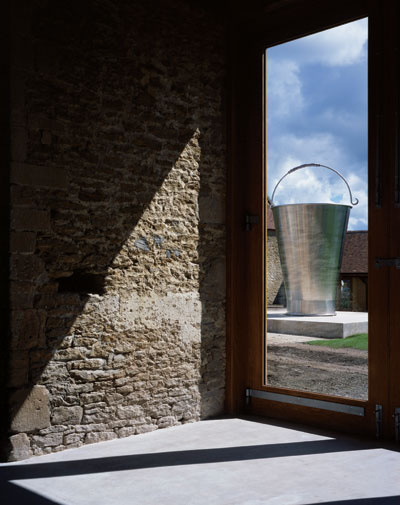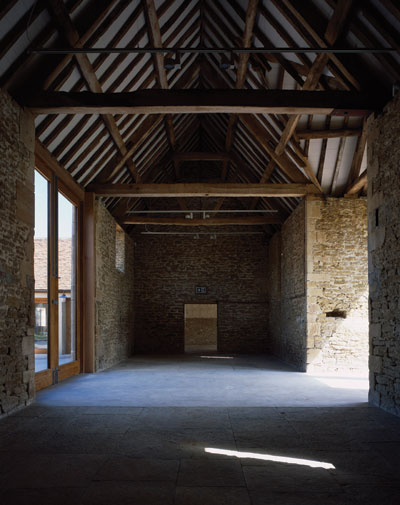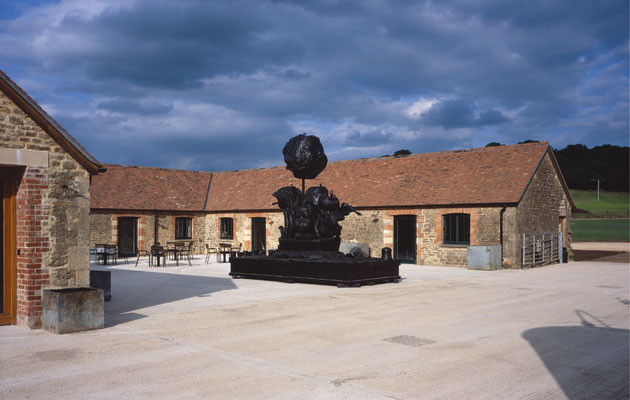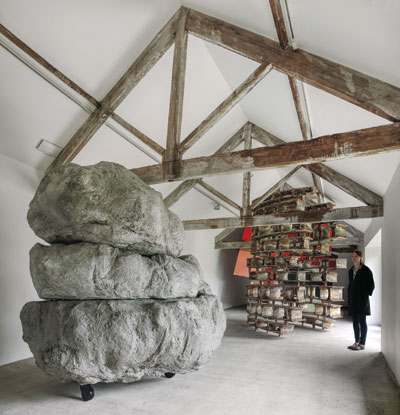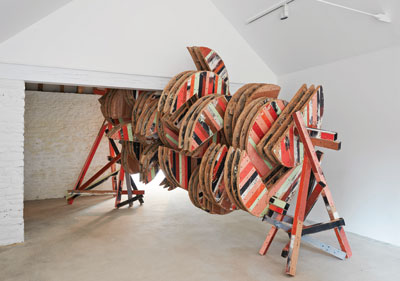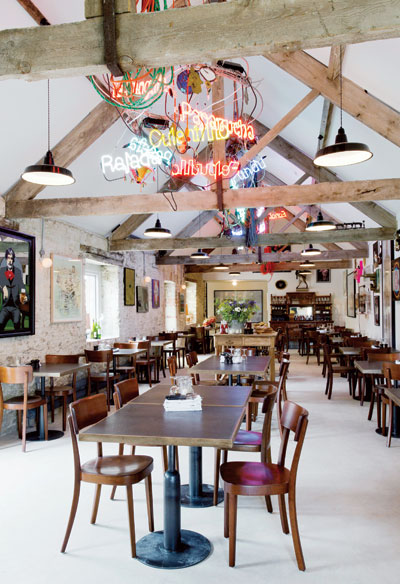|
The new buildings at the Hauser & Wirth gallery are made of brick and have zinc roofs |
||
|
International gallery Hauser & Wirth has made its name attracting the metropolitan super-rich of New York, London and Zurich. So why is its new gallery on a farm in Somerset? With a population of less than 3,000, the Somerset town of Bruton isn’t the likeliest of locations for art powerhouse Hauser & Wirth to take by storm. The private gallery has locations in London, Zurich and New York, but it’s on this quiet patch of fields and farmhouses that Iwan and Manuela Wirth chose to open their first rural outpost in July. Hauser & Wirth Somerset is a sensitive and reverent conversion of a sprawling former farm, designed to attract the public as much the super-rich. The generosity of the move has had the art world asking “Why?” The Swiss couple’s response is simple: “We just fell in love with the place.” The Wirths moved to Bruton to bring up their family years ago, and had been eyeing up the derelict 250-year-old Durslade Farm as a potential hub of food, culture, learning and, above all, world-class art. Noticing a “huge appetite for culture in the countryside”, they bought the land four years ago, before undergoing a series of public consultations to turn the farm into what it is today.
Two new galleries by Luis LaPlace complete the courtyard For the job of transforming mismatched sheds and barns into a set of five coherent gallery spaces with bookshop, classroom and artist’s residence, the Wirths turned to friend and architect Luis LaPlace. The Paris-based Argentinian might not have been the obvious choice for a homage to the English countryside, but his skills for conversion are as sensitive and subtle as any homegrown architect. “We’ve been working in the area for eight years, first on Iwan and Manuela’s house,” he says. “So I know the weather, the materials. I’m very familiar with the vernacular of these villages.” Local firm Benjamin and Beauchamp worked alongside LaPlace. Nestled low in the landscape, the buildings are loosely arranged around a lawn and courtyard. On first arrival, there’s almost nothing to give them away as anything more spectacular than their intended purpose.
Threshing barn with Untitled by Subodh Gupta (2008) outside But coming closer, the clues reveal themselves. First, an oversized milk pail in dazzling stainless steel – Subodh Gupta’s Untitled (2008) – that stands on a plinth facing the main entrance, and then, across the lawn, the words Everything’s Going To Be Alright writ large in white neon across the brick face of the farmhouse by Martin Creed (2011). Iwan Wirth once called LaPlace the “silent architect”, and his work at Durslade is a restrained architecture that yields to the art and nods to the history of the place. Where the original structure has crumbled, LaPlace has stepped in here and there with a slender column of sand-coloured concrete or a section of newly poured floor. “The whole spirit of the project is to respond in a natural way. The farmers who built here were practical, growing the site according to their needs. We tried to do something that would respect the past but is very modern, always using quiet materials.”
Untitled, by Phyllida Barlow, 2014 Two single-storey buildings have been added to the site, completing the circuit of gallery spaces and closing off a central cloistered courtyard. LaPlace calls it the project’s heart. The zinc-roofed pair of brick buildings come to life in the afternoon, enriched by deep shadows from the cloister columns. “The light in Somerset is extraordinary, especially in the afternoons,” he says. “It’s close to the Mediterranean in a way – everything turns gold and red.” The positioning of the two new buildings also heightens anticipation of the gallery’s masterpiece garden, allowing the route through it to come to a crescendo (if there could be such a thing in LaPlace’s architecture of quiet). A riot of perennials at the rear of the site has been planted by Dutch landscape designer Piet Oudolf. The 6,000sq m garden is a swirling meadow of soft grasses, dotted with a mix of colourful wild flowers. “It reads as a print on a ground,” he explains. “The planting scheme is dynamic, meaning it will change very fast through the year. There’s a whole succession, a coming and going of flowers.”
Threshing barn Still taking root, the garden will be fully open to the public in September, but Oudolf encourages several visits to see his planting in different seasons. “A garden is about expectation, it’s not so much about what you see now, but what you will see. That’s how a personal connection is created.” Aptly, the one piece of sculpture chosen for the meadow is time-based – Anri Sala‘s Clocked Perspective (2012) – but the garden can be seen as a work of art in itself. Having collaborated on the High Line, the London Olympic Park and Peter Zumthor’s Serpentine Pavilion of 2011, Oudolf thinks artists and architects like to work with him because his landscapes carry a signature. “I work in a different way, there’s a sense that people can recognise my work.” Every project, he says, starts with a strong picture in his head, fuelled by information about the piece of land and its possibilities. Later he translates these to colour-coded plans, busy drawings with patches and dots denoting different species. The adjoining gallery is filled with his plans for the exhibition Open Field, the first time the drawings have been presented outside Oudolf’s office. |
Words Riya Patel
Images: Hélène Binet, Alex Deflanne and Aaron Schuman, courtesy of the artists and Hauser & Wirth |
|
|
||
|
|
||
|
Ship Adrift, Ship of Fools, Paul McCarthy, 2010-11 The main opening exhibition is by British sculptor Phyllida Barlow, an artist whose colourful and chaotic work is the very antithesis of LaPlace’s architecture. Exaggerated and boisterous forms in scrap materials make you duck and squeeze to get around them; the former threshing barn is dripping in scrappy pompoms that look like the excesses of a larger-than-life village fete. LaPlace is delighted with Barlow’s response: “I love the way Phyllida has taken over the space, it’s so revolutionary. She accepts the architecture how it is, really working with the problematics of odd dimensions, varying heights and qualities of light. When we were working, we thought some of the spaces would be tough for showing art, but not for her!” Barlow created her work before getting the dimensions of the final spaces, which goes some way to explaining quite how closely they nudge and cram into existing features. One didn’t make it in to the building at all – Untitled: Squatboulder (2014) sits forlornly in the courtyard gazing in.
Phyllida Barlow’s work, Untitled and Untitled: Triplestackboulders, 2014, at the opening exhibition GIG “The doorways are tiny, so it was a real ship in a bottle sort of thing,” she says. “The first idea was to go polite and make a series of very small, nice sculptures but I just didn’t have the patience. So these nice sculptures turned into monsters … that kind of press up against the folksy barn-like structures … making the work elbow up against [the building], but at the same time using it.” The sculptures respond to the architecture and location, but it’s clear the disruptive forms don’t speak of an idyll. Not easily romanced by the countryside like LaPlace and Iwan Wirth, Barlow references the darker side of rural life, the industrialisation of the landscape and social effects of mass urban migration in English history. The artist also has an exhibition in Tate Britain’s Duveen Galleries, which runs until 19 October. “I think I came to Somerset four or five times in various degrees of thick mud. It was very difficult to get a sense of what the syntax of the buildings and actual dynamic would be, but that was quite liberating after the Duveen. Working with a space that wasn’t actually there.” It is hoped that immersion in village life will prove formative for other artists in the Hauser & Wirth stable, too. Swiss video artist Pipilotti Rist has already spent a year in Bruton, enrolling her son in the local school and even joining the parent-teacher association (she was particularly moved to help out with its posters, apparently). Mark Wallinger will also spend six months at the site, making work for a future show.
Phyllida Barlow’s work, Untitled: Stashoarding, 2014 Showing contemporary art in the countryside is not an entirely new idea of course – the New Art Centre at Roche Court, Wiltshire has done a successful job of it since 1994. But the altruism of the Wirths’ vision for Durslade Farm makes it most surprising. The galleries and garden are free to enter six days a week and there is an impressive learning and events programme in place for everyone from local schoolchildren to young people, charities and teachers from Somerset and the West Country. With arts funding in the region cut dramatically – including Bristol’s Arnolfini arts centre by 27 per cent – Hauser & Wirth finds itself propping up an ailing system of investment in culture outside London. There are the gallery’s own ends to meet too, and to tempt those with big money out of the capital and its affluent surrounds, Hauser & Wirth Somerset has pulled out all the stops.
Phyllida Barlow’s work, Untitled: Grinder, 2014 Spilling on to the courtyard is a restaurant serving local food with a bar of found objects designed by the son and grandson of artist Dieter Roth, Björn and Oddur Roth. It’s like the tearoom of any tourist attraction, except where the walls of Bruton’s cafes might be lined with quaint watercolours, here they are crammed with some subversive and seriously expensive art. Perhaps the Wirth’s build-it-and-they-will-come attitude has been spurred on by the popularity of projects such as the Turner Contemporary in Margate and the Hepworth Wakefield. But without the pull of statement architecture by the likes of David Chipperfield, or an association with a household name in British art, it remains to be seen how the gallery’s punt on a rural outpost will fare. Although there are talks with train company First Great Western to make Bruton a stop on the fast service between London and Bristol at weekends, for now it’s a three-hour drive from the capital, which may prove amenable only to the dedicated art lover. But maybe that’s no matter. Iwan Wirth has made it clear that the gallery is a labour of love. Not a new model for funding the arts, or an enterprising move to keep the other galleries guessing – just a romantic affair with a dilapidated old farm and a wish to see it alive with activity once more. This article was first published in Icon’s October 2014 issue: Museums, under the headline “Country Hauser”. Buy back issues or subscribe to the magazine for more like this
The Roth Bar & Grill is filled with works by Hauser & Wirth artists |
||

